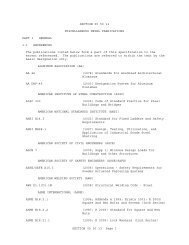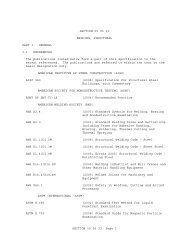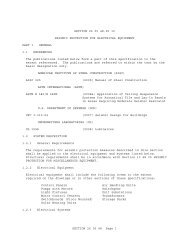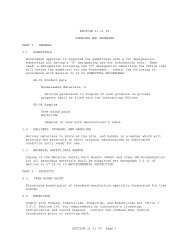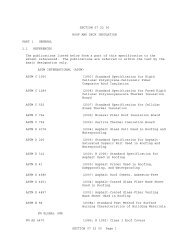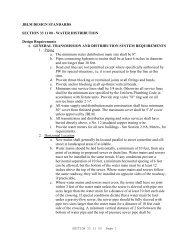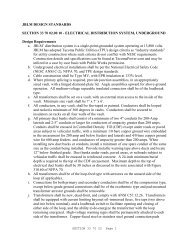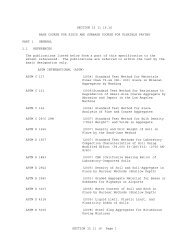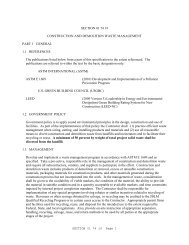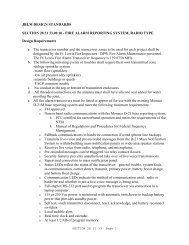LEAD ABATEMENT PLAN FOR BUILDINGS A, B, C AND D - WPC
LEAD ABATEMENT PLAN FOR BUILDINGS A, B, C AND D - WPC
LEAD ABATEMENT PLAN FOR BUILDINGS A, B, C AND D - WPC
- No tags were found...
Create successful ePaper yourself
Turn your PDF publications into a flip-book with our unique Google optimized e-Paper software.
Final<strong>LEAD</strong> <strong>ABATEMENT</strong> <strong>PLAN</strong> <strong>FOR</strong><strong>BUILDINGS</strong> A, B, C <strong>AND</strong> DU.S. Department of CommerceNational Oceanic and Atmospheric Administration – SouthwestFisheries Science CenterLa Jolla, CaliforniaOctober 2011Prepared for:Wade Perrow Construction (<strong>WPC</strong>)P.O. Box 1728Gig Harbor, WA 98335Prepared by:Allied Industries, Inc.5725 Kearny Villa Road, Suite ASan Diego, CA 92123Phone: (619) 955-6811Fax: (619) 955-7935
FINALREVIEW <strong>AND</strong> APPROVAL<strong>LEAD</strong> <strong>ABATEMENT</strong> <strong>PLAN</strong> <strong>FOR</strong><strong>BUILDINGS</strong> A, B, C <strong>AND</strong> DU.S. Department of CommerceNational Oceanic and Atmospheric Administration – Southwest Fisheries Science CenterLa Jolla, CaliforniaOctober 2011Prepared for:WADE PERROW CONSTRUCTION (<strong>WPC</strong>)Project Manager:Jim Bolt, Project Manager10/27/11Date:Lead Abatement Plan Buildings A, B, C and DLa Jolla, Californiai
TABLE OF CONTENTSACRONYMS <strong>AND</strong> ABBREVIATIONS ..................................................................................... IV1.0 INTRODUCTION ...............................................................................................................11.1 PURPOSE STATEMENT ...............................................................................................11.2 PROJECT OBJECTIVE <strong>AND</strong> BACKGROUND IN<strong>FOR</strong>MATION ...........................................12.0 BRIEF PROJECT DESCRIPTION .....................................................................................22.1 <strong>ABATEMENT</strong> ACTIVITY SEQUENCES .........................................................................22.1.1 List of Equipment ........................................................................................32.2 LEVEL OF SUPERVISION ............................................................................................33.0 WORK AREAS ...................................................................................................................43.1 FLOOR SURFACE .......................................................................................................44.0 <strong>LEAD</strong> <strong>ABATEMENT</strong> .........................................................................................................44.1 <strong>LEAD</strong>-BASED PAINT STABILIZATION WORK PRACTICES ...........................................54.2 <strong>LEAD</strong> STABILIZATION WORK METHODS ...................................................................55.0 SITE CONTROL ZONES ...................................................................................................65.1 ON-SITE COMMUNICATIONS .....................................................................................65.2 SITE CONTROL ZONES ...............................................................................................65.2.1 Zone 1: Exclusion Zone ...............................................................................65.2.2 Zone 2: Contamination Reduction Zone ......................................................75.2.3 Zone 3: Support Zone ..................................................................................75.2.4 Site Access Control ......................................................................................75.3 FIRE <strong>AND</strong> MEDICAL EMERGENCY RESPONSE PROCEDURES .......................................76.0 EXPOSURE ASSESSMENT <strong>AND</strong> MONITORING ..........................................................86.1 <strong>LEAD</strong> HAZARD STABILIZATION .................................................................................87.0 COMMUNICATION ...........................................................................................................97.1 HAZARDOUS COMMUNICATION ................................................................................97.2 NOTIFICATION ...........................................................................................................98.0 MEDICAL SURVEILLANCE ..........................................................................................109.0 RECORDKEEPING ..........................................................................................................109.1 EXPOSURE ASSESSMENT <strong>AND</strong> MEASUREMENTS ......................................................109.2 MEDICAL SURVEILLANCE .......................................................................................10Lead Abatement Plan Buildings A, B, C and DLa Jolla, Californiaii
TABLE OF CONTENTS9.3 TRAINING RECORDS ................................................................................................119.4 RECORDS OF REQUIRED NOTIFICATIONS .................................................................1110.0 TRAINING REQUIREMENTS ........................................................................................1110.1 <strong>LEAD</strong> HAZARD <strong>ABATEMENT</strong>/STABILIZATION TRAINING .........................................1111.0 RESPIRATORY PROTECTION ......................................................................................1211.1 RESPIRATOR PROGRAM ...........................................................................................1212.0 PERSONAL PROTECTIVE EQUIPMENT .....................................................................13APPENDICESAppendix A – Ninyo & Moore Site MapAppendix B – Ninyo & Moore Hazardous Material Location MapsAppendix C – MSDSLead Abatement Plan Buildings A, B, C and DLa Jolla, Californiaiii
ACRONYMS <strong>AND</strong> ABBREVIATIONSAlliedCCRCFRCRZDOTELEZf/ccHEPAHVACIHLBPLDRMSDSNEAOSHAPELPMSSHOSWFSCSWPSZTSITWAAllied Industries, Inc.California Code of RegulationsCode of Federal RegulationsContamination reduction zoneDepartment of TransportationExcursion limitExclusion zoneFiber per cubic centimeterHigh-efficiency particulate airHeating, ventilating and air conditioningIndustrial HygienistLead-based paintLand disposal restrictionsMaterial Safety Data SheetNegative exposure assessmentOccupational Safety and Health AdministrationPermissible exposure limitProject ManagerSite Safety and Health OfficerSouthwest Fisheries Science CenterSafe Work PracticesSupport zoneThermal system insulationTime-weighted averageLead Abatement Plan Buildings A, B, C and DLa Jolla, Californiaiv
1.0 INTRODUCTIONWade Perrow Construction (<strong>WPC</strong>) has contracted Allied Industries, Inc. (Allied) to performstabilization of lead-based paint (LBP) in Buildings A, B, C and D prior to performing buildingsdemolition and renovation. The four buildings are owned by the U.S. Department of Commerce,located in La Jolla, California.Allied plans to stabilize loose and flaky paint associated with the following materials inBuildings A, B, C and D prior to performing building demolition and renovation: door (woodand metal), door casing and jamb, wall pipe, wall, baseboard, floor drain and pipe, and electricalbox. All stabilized LBP materials and lead-containing material (i.e. toilet and sink) will be left inplace during demolition.This Lead Abatement Plan includes relative information and outline procedures for field crews tofollow and be in compliance with the federal, state, and local lead regulations. The objective isto stabilize LBP building components from Buildings A, B and C prior to performing anydemolition activity and Building D prior to performing renovation activity.1.1 PURPOSE STATEMENTThe purpose of this Lead Abatement Plan is to establish compliance with the OccupationalSafety and Health Administration's (OSHA) lead standard, as defined in Title 29 Code of FederalRegulations (CFR) 1926.1101, 29 CFR 1926.58 and Title 8 California Code of Regulation(CCR) 1932.1 requirements by ensuring that employees, subcontractors, and the general publicare not exposed to lead hazards during the course of and after the conclusion of this project.1.2 PROJECT OBJECTIVE <strong>AND</strong> BACKGROUND IN<strong>FOR</strong>MATIONThe objective of this Lead Abatement Plan is to support <strong>WPC</strong> in providing building demolitionservices for Buildings A, B and C and restrooms renovation of Building D, all buildings in whichowned by the U.S. Department of Commerce. This action requires the removal and stabilizationof the existing LBP components. The following information pertains to the involved parties.Owner:U.S. Department of Commerce (leased by National Oceanic andAtmospheric Administration – Southwest Fisheries Science Center)Site Address: 8604 La Jolla Shores Drive, La Jolla, California 92037General Contractor:Subcontractor:Wade Perrow Construction (<strong>WPC</strong>)Allied Industries, Inc (Allied)Lead Abatement Plan Buildings A, B, C and DLa Jolla, California 1
2.0 BRIEF PROJECT DESCRIPTIONBuildings A, B, C and D of the U.S. Department of Commerce are leased by the SouthwestFisheries Science Center (SWFSC). Building A is approximately 6,000-square foot four-storybuilding. Buildings B and C are approximately 2,400 square foot three-story buildings.Buildings D is approximately 8,000 square foot four-story building. Each of the building isconstructed with cast-in-place concrete and contained LBP associated with the some existingbuilding components/materials.2.1 <strong>ABATEMENT</strong> ACTIVITY SEQUENCESPrior to conducting any abatement activity, the following sequences of activities will beperformed:• Pre-abatement survey/ site walk;• Send written notifications and scheduling;• Establish site control zone (including regulated area); and• Control safe work environment and comply with existing regulations.Once the site control zone has been setup, the lead stabilization activities are projected to bedone in the following orders by per building and story:1. Building C: stabilize LBP for demolition.• 2 nd Floor• 1 st Floor• Basement2. Building B: stabilize LBP for demolition.• 3 rd Floor• 2 nd Floor• 1 st Floor3. Building A: stabilize LBP for demolition.• 4 th Floor• 3 rd FloorLead Abatement Plan Buildings A, B, C and DLa Jolla, California 2
• 2 nd Floor• 1 st Floor4. Building D: stabilize LBP for renovation.• 2 nd Floor• 1 st Floor2.1.1 List of EquipmentAllied foresees that the following equipment/machines will be used on-site to support theabatement project at Buildings A, B, C and D:• High-efficiency particulate air (HEPA) vacuum;• High-efficiency particulate air (HEPA) negative air units• Scissor lifts/ladders• Floor machines/heavy bars• Excavator/ loader equipment.2.2 LEVEL OF SUPERVISIONAllied management personnel have the authority and responsibility for implementing andmaintaining this Lead Abatement Plan. Position titles and a description of specificresponsibilities, lines of authority and communication for the field work, are included below.The Project Manager (PM) for this project is Jim Bolt; the Industrial Hygienist (IH) is ShaunCornish from Cornish Asbestos Consultant (C.A.C.); and the Site Safety and Health Officer(SSHO)/ Competent Person that has been appointed by the PM is Ricardo Rodriguez.• PM• IH- Coordinate development and implementation of this plan; and- Communicate specific training needs to the subsidiary SSHO.- Coordinate this plan within the subsidiary or region;- Maintain plan files; andLead Abatement Plan Buildings A, B, C and DLa Jolla, California 3
- Investigate accidents to determine their root cause(s) and identify correctiveactions.- Conduct air monitoring and clearance and assess work environment conditions.• SSHO (competent person)- Implement this plan;- Evaluate the effectiveness of this plan; and- Verify that the correction of unsafe conditions is properly implemented.• Employees- Comply with established health and safety programs and this plan; and- Immediately report to the IH, SSHO or PM of unsafe acts or conditions andsituations which cannot easily be corrected.3.0 WORK AREASThe access point to the regulated area is limited to authorized personnel who meet theappropriate state or federal regulations. All persons entering a regulated area where employeesare required to wear proper personal protective equipment (PPE), including respirator. TheSSHO/competent person will supervise all lead work performed within the regulated areas.3.1 FLOOR SURFACEDepending on the abatement activities and/or as necessary, floor cover of the regulated area willbe covered with at least one (1) layer of six (6) mil fire retardant poly, turning up the walls atleast twelve (12) inches (300 mm). The poly will form a right angle at the floor-wall juncture sothere is no radius which can be stepped on, possibly causing detachment of the poly. Spray glueand duct tape will both be used for floor seams. Floor seams will overlap a minimum of six (6)feet or be at right angles to each other.4.0 <strong>LEAD</strong> <strong>ABATEMENT</strong>This section discusses LBP work practices and methods for stabilizing loose and flaky paintassociated with the following materials in Buildings A, B, C and D: door (wood and metal), doorcasing and jamb, wall pipe, wall, baseboard, floor drain and pipe, and electrical box. Allstabilized LBP materials and lead-containing material (i.e. toilet and sink) will be left in placeduring demolition. The demolition waste will be characterized by collecting representativesamples of the building demolition debris and be tested for toxicity characteristic leachingprocedure (TCLP). The result of the TCLP samples will determine the disposing landfill.Lead Abatement Plan Buildings A, B, C and DLa Jolla, California 4
4.1 <strong>LEAD</strong>-BASED PAINT STABILIZATION WORK PRACTICESBecause of the low risk associated with lead stabilization work, full containment of the work areais not anticipated. At a minimum, a lead hazard exclusion zone will be established around allareas of LBP removal. Only trained and authorized Allied field personnel wearing properpersonal protective equipment (PPE) will be allowed to enter lead hazard exclusion zone. Theexclusion zone will include areas where tarpaulins are placed on the ground below LBP removalareas to capture and collect paint chips, dust and debris. Lead hazard warning signs compliantwith Proposition 65 requirements will be posted outside the exclusion zone perimeter. Theperimeter of the exclusion zone will be within 5 to 10 feet of the work area as determined by theabatement work teams. Entry and exit points will be identified and will be the sole means ofaccess to the exclusion zone.Loose and flaky paint will only be removed by wet scraping method. During wet scraping, theLBP is kept moist by continuously wetting the area with a spray bottle or sponge. Enoughamended water is applied to moisten the surface completely but not so much that large amountsrun onto the floor or ground. The wetting eliminates dust hazards during paint removal.4.2 <strong>LEAD</strong> STABILIZATION WORK METHODSMechanical tools may also be used but only if they are equipped with high-efficiency particulateair (HEPA) exhaust devices and operated in a way that precludes emissions of lead dust asconfirmed through baseline air monitoring. No needle guns, heat guns, and vacuum blasting willbe used during the abatement project.During paint removal activities, efforts will be made to minimize lead dust and fumes. All debriswill be collected either by hand, wet wiping, and/or HEPA vacuum. No dry sweeping of LBPdebris will occur. Collected debris will be placed into a waste bag and loaded to the U.S.Department of Transportation (USDOT)-approved container for disposal. The waste bags willbe labeled as hazardous waste with the contents, accumulation date, and contact informationdisplayed.Upon completion of work, non-disposable tools, PPE, and equipment will be decontaminated byHEPA vacuuming or by cleaning with wet wipes. Personnel will also decontaminate themselvesin a similar fashion. Disposable equipment and PPE will be properly containerized and disposedof as hazardous waste with the removed LBP debris. Decontamination will occur in thecontamination reduction zone (CRZ).After all abatement activities are completed, Allied competent person will check the area toconfirm that immediate lead hazards have been stabilized.Lead Abatement Plan Buildings A, B, C and DLa Jolla, California 5
5.0 SITE CONTROL ZONESThe following sections discuss measures and procedures for site control zone and regulated area,which include on-site communications, site control zones, site access control, and securityprocedures.5.1 ON-SITE COMMUNICATIONSSuccessful communication between field teams and personnel in the support zone is essential. Innon-combustible atmospheres, the following communication systems will be available duringsite activities:• Cellular telephones• Two-way radios5.2 SITE CONTROL ZONESTo control the spread of contamination and employee exposures to chemical and physicalhazards, on-site work areas will be divided into an exclusion zone, a contamination reductionzone (CRZ), and a support zone.Access to the exclusion zone and CRZ will be restricted to authorized personnel. Visitors tothese areas must present proper identification and be authorized to be on site. The SSHO willidentify work areas that visitors or personnel are authorized to enter and will enforce site controlmeasures.The following sections describe the exclusion zone, the CRZ, and the support zone as well asprocedures to be followed in each.5.2.1 Zone 1: Exclusion ZoneA formally established exclusion zone is required for Buildings A, B, C and D. An exclusionzone includes areas where contamination is either known or likely to be present or, because ofwork activity, has the potential to cause harm to personnel. Unless otherwise specified by theSSHO, the perimeter of the exclusion zone and an appropriate radius around work task areas willbe demarcated by a physical barrier, such as barricade tape or traffic cones, to restrict access. Adaily roster with the date of each person’s entrance into the exclusion zone; the person’s name,signature, and organization; and the time of entry and exit will be kept for personnel working inthe zone. Visitors will not be permitted to enter the exclusion zone without proper qualifications,equipment, and SSHO authorization.Lead Abatement Plan Buildings A, B, C and DLa Jolla, California 6
5.2.2 Zone 2: Contamination Reduction ZoneA formally established CRZ is required for Buildings A, B, C and D. The CRZ will contain thedecontamination area to decontaminate personnel. Visitors will not be permitted to enter thedecontamination zone without proper qualifications and SSHO authorization.The decontamination area will be established in accordance to 29 CFR 1910.1101 and Title 8CCR 1529. The one-stage decontamination unit (Class II work) which only includes theequipment room (change room) will be provided on-site.5.2.3 Zone 3: Support ZoneA formally established support zone is required for Buildings A, B, C and D. A support zonemay consist of uncontaminated and non-hazardous parts of the site. The support zone should besituated in an area generally upwind of an exclusion zone whenever possible. Site visitors notmeeting training, medical surveillance, and PPE requirements must stay in the support zone.5.2.4 Site Access ControlOnly authorized personnel will be permitted within the regulated area. The site will bedelineated through the use of caution tape, cone and/or fencing where appropriate. Warningsigns will be posted at regular intervals around the perimeter and at entrances to the regulatedarea. Posted signs will be in English and Spanish. At least one person (i.e. SSHO/CompetentPerson) will be outside of the regulated area to ensure proper procedures listed above arefollowed.5.3 FIRE <strong>AND</strong> MEDICAL EMERGENCY RESPONSE PROCEDURESFire extinguishers will be kept on site at all times for use in the event of a fire. If a fire ormedical emergency arises, the Fire Station 9 – La Jolla will be contacted at the followingnumbers:Emergency: 911Fire Station 9: (619) 533-4300Further treatment of personnel will be transported to the off-site hospital below.Scripps Memorial Hospital – La Jolla9888 Genesee AvenueLa Jolla, California 92037(858) 626-4123Lead Abatement Plan Buildings A, B, C and DLa Jolla, California 7
The following emergency equipment will be available on-site:• First Aid kit;• Portable eye wash (the portable eye wash until will meet the requirements of theAmerican National Standards Institute Standard Z 358.1-2004 or later criteria); and• Fire extinguisher (at least two (2) on every floor, and one (1) for any additional 2,500square feet of the work area).6.0 EXPOSURE ASSESSMENT <strong>AND</strong> MONITORING6.1 <strong>LEAD</strong> HAZARD STABILIZATIONInitial baseline air monitoring is also known as Negative Exposure Assessment (NEA).According to OSHA and Cal/OSHA, an NEA must be conducted whenever embarking on arenovation or repair program for LBP. The NEA is necessary to determine levels of leadcontainingdust that workers will be exposed to so that the necessary PPE and other protectiveand cleanup measures can be determined. It is also necessary to determine the level of trainingthat will be required by the CDHS.While conducting the NEA and prior to receiving the NEA results, Allied assume that exposureexceeds the PEL and the requirements below must be met.• Workers must wear protective clothing and respirators;• Workers must have the proper training to conduct lead abatement work;• Personal hygiene and sanitary stations with suitable supplies must be available;• Workers must have blood tests to determine their baseline lead levels;Allied will perform the NEA by conducting air monitoring. Sampling will be conducted bycollecting dust samples on filter cassettes in the breathing zone of the workers over a full shift.Sampling will be supervised by a IH and the samples analyzed by an accredited AmericanIndustrial Hygiene Association (AIHA) laboratory. The IH will interpret the analytical results. Ifnecessary, periodic sampling will also be conducted until completion of the assigned tasks.During this initial sampling, all workers will wear protective coveralls, head and hand protection,and, at a minimum, a half- face respirator that has been suitably fit-tested. All workers willfollow the three zone rules in Section 6.2.Lead Abatement Plan Buildings A, B, C and DLa Jolla, California 8
Cal/OSHA has assigned an action level for lead dust exposure of 30 micrograms per cubic meter(µg/m 3 ) and PEL is 50 µg/m 3 .7.0 COMMUNICATION7.1 HAZARDOUS COMMUNICATIONCommunication of hazards follows the requirements of 29 CFR 1926.1101(k) and containsinformation and procedures for the following:• Duties of building and facility owners;• Duties of employers whose employees perform work;• Warning signs;• Labels;• Employee information and training; and• Access to training materials.7.2 NOTIFICATIONPersons who use, occupy, or are affected by areas where LBP work will occur will be notifiedprior to the start of the work. In addition, OSHA regulations include mandatory notification ofcertain personnel prior to the performance of work regulated by OSHA. This notification isrequired if these employers or their employees will be performing work in or adjacent to areaswhere LBP are located. Notification will be done in writing.The owner (U.S. Department of Commerce) of a building is required by OSHA to notify thefollowing personnel about the presence, location, and quantity of LBP:• Prospective employers working, applying (contractor and subcontractor) for orbidding for work;• Employees of the owner;• Tenants.Personnel should be given information about the specific work to be performed, the workschedule, precautions being taken, what will be visible during the work, and that posted warningsigns must be obeyed. A general notice to affected personnel might be more convenient thanLead Abatement Plan Buildings A, B, C and DLa Jolla, California 9
notifying these personnel each time work occurs. State and local regulations may also includepersonnel notification requirements.8.0 MEDICAL SURVEILLANCEA medical surveillance program is instituted for all employees who are exposed to at or abovethe PEL. Employees that are required to wear a negative pressure respirator are examined toverify that they are physically able to perform the work. All medical examinations andprocedures are performed by or under the supervision of a licensed physician, and are providedat no cost to the employee and at a reasonable time and place.9.0 RECORDKEEPING9.1 EXPOSURE ASSESSMENT <strong>AND</strong> MEASUREMENTSThis record includes at least the following information:• The date of measurement;• The operation involving exposure to lead that is being monitored;• Sampling and analytical methods used and evidence of their accuracy;• Number, duration, and results of samples taken;• Type of protective devices worn, if any; and• Name, social security number, and exposure of the employees whose exposures arerepresented.The record will be maintained for at least thirty (30) years.9.2 MEDICAL SURVEILLANCEAn accurate record is maintained for each employee subject to medical surveillance inaccordance with 29 CFR 1910.1020. The record includes at least the following information:• The name and social security number of the employee;• A copy of the employee's medical examination results, including the medical history,questionnaire responses, results of any tests, and physician's recommendations;• Physician's written opinions;Lead Abatement Plan Buildings A, B, C and DLa Jolla, California 10
• Any employee medical complaints related to exposure to lead; and• A copy of the information provided to the physician as required by paragraph (m) ofthis section.The record is maintained for the duration of employment, plus thirty (30) years.9.3 TRAINING RECORDSEmployee training records are kept for one (1) year after the last date of employment by Allied.9.4 RECORDS OF REQUIRED NOTIFICATIONSWhere the building owner has communicated and received information concerning theidentification, location and quantity of LBP, written records of such notifications and theircontents are maintained by the building owner for the duration of ownership and then transferredto successive owners of such buildings/facilities.10.0 TRAINING REQUIREMENTS10.1 <strong>LEAD</strong> HAZARD <strong>ABATEMENT</strong>/STABILIZATION TRAININGCal/OSHA has assigned an action level for lead dust exposure of 30 micrograms per cubic meter(µg/m 3 ) and PEL is 50 µg/m 3 . If air sampling results are less than the action level, the followingrequirements apply:• HAZCOM training ;• Dust suppression methods (wet methods and HEPA vacuum cleanup);• Hand-washing facilities; and• Employee notification;If dust sampling results are at or above the action level, the following applies in addition to therequirements stated above:• “Action Level Training” or additional training on subjects presented in the LeadStandards (2 to 8 hours average and annually)• Additional air sampling;• CDPH supervisor/worker training and state certification;Lead Abatement Plan Buildings A, B, C and DLa Jolla, California 11
• Blood testing;• If exposure is expected to last more than 30 days, full medical surveillance;• Written compliance plan;If dust sampling results are at or above the PEL, the following requirements apply:• Respirators (full- or half-face, depending on levels detected);• Protective clothes and decontamination steps;• Containment;• Change facilities and showers (at end of the day);• Written compliance plan;• CDHS certification;• Posting of Proposition 65-compliant lead warning signs.11.0 RESPIRATORY PROTECTION• During all work covered by this section where employees are exposed above theTWA or excursion limit;• During all work related to lead hazard abatement/stabilization;• In emergencies.Respirators are selected and provided at no cost to employees. Filtering face-piece respiratorsare not utilized for use against lead dust and particulates. HEPA-equipped, tight fitting, negativepressure half face with the National Institute for Occupational Safety and Health (NIOSH)approved P-100 cartridges are utilized for this project. This respirator will provide adequateprotection to the employee.11.1 RESPIRATOR PROGRAMWhen required to use respiratory protection, the program instituted is in accordance with 29 CFR1910.134(b) through (d) (except (d)(1)(iii)), and (f) through (m).A respirator program has been developed to satisfy the requirements of this lead related project.Lead Abatement Plan Buildings A, B, C and DLa Jolla, California 12
Components of the respirator program include prohibiting the assignment of lead work thatrequires respirator use if, based on their most recent medical examination, the examiningphysician determines that the employee will be unable to function normally while using arespirator, or that the safety or health of the employee or other employees will be impaired by theemployee's respirator use.Those employees will be assigned to another job or given the opportunity to transfer to adifferent position, the duties of which they are able to perform with the same employer, in thesame geographical area, and with the same seniority, status, and rate of pay and other jobbenefits they had just prior to such transfer, if such a different position is available.Respirators issued to employees exhibit the least possible face-piece leakage and are fittedproperly. Quantitative or qualitative face fit tests are conducted:• Before any employee is required to use any respirator with a negative or positivepressure tight-fitting face piece;• Whenever a different respirator face piece (size, style, model, or make) is used;• At least annually;• Whenever the employee reports, or our company, the physician or other licensedhealth care professional (PLHCP), supervisor, or Program Administrator makesvisual observations of, changes in the employee's physical condition that could affectrespirator fit. Such conditions include, but are not limited to, facial scarring, dentalchanges, cosmetic surgery, or an obvious change in body weight; and• When the employee, subsequently after passing a qualitative or quantitative fit test,notifies the company, Program Administrator, supervisor, or PLHCP that the fit of therespirator is unacceptable. That employee will be retested with a different respiratorface piece.12.0 PERSONAL PROTECTIVE EQUIPMENTThe use of protective clothing, such as coveralls (Dupont Tyvek) or similar whole-body clothing,head coverings, gloves, eye-protection and foot coverings are provided to employees andrequired for:• Lead abatement/stabilization task.Laundering of contaminated clothing is done so as to prevent the exposure to lead.Contaminated clothing is transported in sealed impermeable bags, or other closed, impermeablecontainers and labeled.Lead Abatement Plan Buildings A, B, C and DLa Jolla, California 13
The competent person examines work suits worn by our employees at least once per work shiftfor rips or tears that may occur during performance of work. When rips or tears are detectedwhile an employee is working, they will be immediately mended, or the work suit shall beimmediately replaced.The Level C PPE are to be used for field work at Buildings A, B, C and D have been selectedbased on known or anticipated physical hazards; types and concentrations of contaminants thatmay be encountered on site; and contaminant properties, toxicity, exposure routes, and matrixesand as follow:• Level C- Coveralls or work clothes;- Chemical-resistant clothing (such as Tyvek ® or Saranex ® coveralls);- Outer gloves (neoprene, nitrile, or other), if applicable;- Disposable inner gloves (nitrile or vinyl);- Boots with steel-toe protection and steel shanks;- Disposable boot covers or chemical-resistant outer boots;- Full- or half-face, air-purifying respirator with NIOSH-approved P100 filtercartridges to protect against dust (cartridges must be replaced in accordance withthe change-out schedule);- Safety glasses or goggles (with a half-face respirator only);- Hard hat (face shield optional); and- Hearing protection (for areas with a noise level exceeding 85 dBA)• Level B- Chemical-resistant clothing (such as Tyvek ® or Saranex ® coveralls);- Outer gloves (neoprene, nitrile, or other);- Disposable inner gloves (nitrile or vinyl);- Boots with steel-toe protection and steel shanks;- Disposable boot covers or chemical-resistant outer boots;- NIOSH-approved, pressure-demand airline respirator with a 5-minute escapecylinder or self-contained breathing apparatus (SCBA);Lead Abatement Plan Buildings A, B, C and DLa Jolla, California 14
- Hard hat (face shield optional); and- Hearing protection (for areas with a noise level exceeding 85 dBA);Lead Abatement Plan Buildings A, B, C and DLa Jolla, California 15
APPENDIX ANINYO & MOORE SITE <strong>PLAN</strong>
APPENDIX BNINYO & MOORE HAZARDOUS MATERIALS LOCATION MAPS
APPENDIX CMSDS
msds_alconox_english_oshaALCONOX MSDSSection 1 : MANUFACTURER IN<strong>FOR</strong>MATIONProduct name: AlconoxSupplier: Same as manufacturer.Manufacturer: Alconox, Inc.30 Glenn St.Suite 309White Plains, NY 10603.Manufacturer emergency 800-255-3924.phone number: 813-248-0585 (outside of the United States).Manufacturer: Alconox, Inc.30 Glenn St.Suite 309White Plains, NY 10603.Supplier MSDS date: 2005/03/09D.O.T. Classification: Not regulated.C.A.S.25155-30-0497-19-87722-88-57758-29-4CONCENTRATION%Section 2 : HAZARDOUS INGREDIENTSIngredient Name T.L.V. LD/50 LC/5010-30 SODIUMDODECYLBENZENESULFONATENOTAVAILABLE7-13 SODIUM CARBONATE NOTAVAILABLE438MG/KGRAT ORAL1330MG/KGMOUSEORAL4090MG/KGRAT ORAL6600MG/KGMOUSEORAL10-30 TETRASODIUM PYROPHOSPHATE 5 MG/M3 4000MG/KGRAT ORAL2980MG/KGMOUSEORAL10-30 SODIUM PHOSPHATE NOTAVAILABLE3120MG/KGRAT ORAL3100MG/KGMOUSEORAL>4640MG/KGRABBITDERMALNOTAVAILABLE2300MG/M3/2HRATINHALATION1200MG/M3/2HMOUSEINHALATIONNOTAVAILABLENOTAVAILABLEMS 01.10.01.03.04.0 Page 1 of 4
msds_alconox_english_oshaSection 2A : ADDITIONAL INGREDIENT IN<strong>FOR</strong>MATIONNote: (supplier).CAS# 497-19-8: LD50 4020 mg/kg - rat oral.CAS# 7758-29-4: LD50 3100 mg/kg - rat oral.Section 3 : PHYSICAL / CHEMICAL CHARACTERISTICSPhysical state: SolidAppearance & odor: Almost odourless.White granular powder.Odor threshold (ppm): Not available.Vapour pressure(mmHg):Not applicable.Vapour density (air=1): Not applicable.By weight: Not available.Evaporation rate(butyl acetate = 1):Not applicable.Boiling point (°C): Not applicable.Freezing point (°C): Not applicable.pH: (1% aqueous solution).9.5Specific gravity @ 20 °C: (water = 1).0.85 - 1.10Solubility in water (%): 100 - > 10% w/wCoefficient of water\oildist.:VOC: NoneNot available.Section 4 : FIRE <strong>AND</strong> EXPLOSION HAZARD DATAFlammability: Not flammable.Conditions ofSurrounding fire.flammability:Extinguishing media: Carbon dioxide, dry chemical, foam.WaterWater fog.Special procedures: Self-contained breathing apparatus required.Firefighters should wear the usual protective gear.Auto-ignitionNot available.temperature:Flash point (°C),method: NoneLower flammabilitylimit (% vol):Upper flammabilitylimit (% vol):Not available.Sensitivity to mechanicalimpact:Not applicable.Not applicable.Not applicable.Hazardous combustion Oxides of carbon (COx).products: Hydrocarbons.Rate of burning: Not available.Explosive power: NoneMS 01.10.01.03.04.0 Page 2 of 4
msds_alconox_english_oshaSection 5 : REACTIVITY DATAChemical stability: Stable under normal conditions.Conditions of instability: None known.HazardousWill not occur.polymerization:Incompatible Strong acids.substances: Strong oxidizers.HazardousSee hazardous combustion products.decomposition products:Section 6 : HEALTH HAZARD DATARoute of entry: Skin contact, eye contact, inhalation and ingestion.Effects of AcuteExposureEye contact: May cause irritation.Skin contact: Prolonged contact may cause irritation.Inhalation: Airborne particles may cause irritation.Ingestion: May cause vomiting and diarrhea.May cause abdominal pain.May cause gastric distress.Effects of chronicContains an ingredient which may be corrosive.exposure:LD50 of product, species> 5000 mg/kg rat oral.& route:LC50 of product, speciesNot available for mixture, see the ingredients section.& route:Exposure limit ofNot available for mixture, see the ingredients section.material:Sensitization to product: Not available.Carcinogenic effects: Not listed as a carcinogen.Reproductive effects: Not available.Teratogenicity: Not available.Mutagenicity: Not available.Synergistic materials: Not available.Medical conditionsNot available.aggravated by exposure:First AidSkin contact: Remove contaminated clothing.Wash thoroughly with soap and water.Seek medical attention if irritation persists.Eye contact: Check for and remove contact lenses.Flush eyes with clear, running water for 15 minutes while holdingeyelids open: if irritation persists, consult a physician.Inhalation: Remove victim to fresh air.Seek medical attention if symptoms persist.Ingestion: Dilute with two glasses of water.Never give anything by mouth to an unconscious person.Do not induce vomiting, seek immediate medical attention.MS 01.10.01.03.04.0 Page 3 of 4
msds_alconox_english_oshaSection 7 : PRECAUTIONS <strong>FOR</strong> SAFE H<strong>AND</strong>LING <strong>AND</strong> USELeak/Spill: Contain the spill.Recover uncontaminated material for re-use.Wear appropriate protective equipment.Contaminated material should be swept or shoveled intoappropriate waste container for disposal.Waste disposal: In accordance with municipal, provincial and federal regulations.Handling procedures andequipment:Protect against physical damage.Avoid breathing dust.Wash thoroughly after handling.Keep out of reach of children.Avoid contact with skin, eyes and clothing.Launder contaminated clothing prior to reuse.Storage requirements: Keep containers closed when not in use.Store away from strong acids or oxidizers.Store in a cool, dry and well ventilated area.Precautionary MeasuresGloves/Type:Section 8 : CONTROL MEASURESRespiratory/Type:Neoprene or rubber gloves.Eye/Type:If exposure limit is exceeded, wear a NIOSH approved respirator.Safety glasses with side-shields.Footwear/Type: Safety shoes per local regulations.Clothing/Type: As required to prevent skin contact.Other/Type: Eye wash facility should be in close proximity.Emergency shower should be in close proximity.VentilationLocal exhaust at points of emission.requirements:MS 01.10.01.03.04.0 Page 4 of 4
MATERIAL SAFETY DATA SHEETfiberset pm ®Per OSHA-recommended ANSI Z400.1-2004 standard format & in accordance withEuropean standard formatSECTION 1: PRODUCT <strong>AND</strong> COMPANY IDENTIFICATIONProduct Name: Fiberset PMProduct Description: Post-Removal Surface Sealant - WhiteProduct Code: 7470Manufacturer: Fiberlock Technologies, Inc.Address:Fiberlock Technologies150 Dascomb RoadAndover MA, 01810Contact Info:Tel: (800) 342-3755Fax: (978) 475-6205Emergency Phone: 24 Hour Contact: CHEM-TEL: (800) 255-3924INTERNATIONAL 24 HOUR EMERGENCY Phone: 813-248-0585SECTION 5: FIRE-FIGHTING MEASURESProduct is non-combustible.Flash point:F: Not flammableC: Not flammableExtinguishing Media:Autoignition Temperature:F: Not EstablishedC: Not EstablishedUse extinguishing media appropriate for surrounding fireWater SprayOKCarbon DioxideOKFoamOKDry ChemicalOKHalonOKOtherAny “ABC” ClassMSDS DATE: 3/10/09SECTION 2: COMPOSITION/IN<strong>FOR</strong>MATION ON INGREDIENTSNon-hazardous:Pigmented Latex emulsion coating comprised of water, pigments, fillers, additives,and latex emulsion resin.Hazardous:Chemical Name CAS# Percent Exposure Limits1 - Titanium dioxide 13463-67-7 < 2.0 ACGIH TLV10 mg/m 3 as DustOSHA PEL10 mg/m 3 as Total Dust5 mg/m 3 Respirable FractionNote: Normal application procedures pose no hazard since titanium dioxide iswetted and encapsulated, but grinding or sanding dried films of this product mayyield respirable titanium dioxide dust. Control exposures to less than 0.1 mg/m3using NIOSH/MSHA-approved dust filter respirators.Note: Per 29CFR 1910.1200 (g) (2) (1) (C) (2), only hazardous substancespresent in excess of 1.0% by weight (or 0.1% for carcinogens) must be listed onan MSDS.SECTION 3: HAZARDS IDENTIFICATIONEmergency Overview:Product Description: This product is a pigmented liquid.Health Hazards:Eyes: May cause slight irritation.Skin: Substance may cause slight skin irritation.Inhalation: May cause irritation of respiratory tract.Ingestion: Ingestion may cause gastrointestinal irritation, nausea, and vomitting.Flammability Hazards: This product is not flammable. If this product is involvedin a fire, the decomposition products generated will include irritating vapors andgases and some carbon monoxide.Reactivity Hazards: This product is not reactive.Environmental Hazards: Although release of this product to the environment isnot expected to cause significant adverse effect, all releases should be avoided.SECTION 4: FIRST AID MEASURESEyes: Immediately flush eyes with plenty of water for at least 15 minutes andconsult physician.Skin: Wash skin thoroughly with soap and water. If drenched with product,remove and wash clothing before reuse.Ingestion: Ingestion If victim is conscious give 2 glasses of water. Call aphysician.Inhalation: N/ASECTION 6: ACCIDENTAL RELEASE MEASURESAccidental Release Measures:Personal Precautions: Do not get in eyes. Do not take internally. Avoid skincontact. Prevent prolonged or repeated breathing of vapor or spray mists. Keepunnecessary people away. Floor may be slippery, use care to avoid falling.Ventilate the area. Remove with inert absorbent.Environmental Precautions: Keep spills and cleaning run-offs out of municipalsewers and open bodies of water. Comply with local, state and nationalregulations.SECTION 7: H<strong>AND</strong>LING <strong>AND</strong> STORAGEHandling and Storage:Storage: Store in a cool, dry placeKeep closure tight and containers upright to prevent leakage.Precautionary labeling: “KEEP FROM FREEZING”.SECTION 8: EXPOSURE CONTROLS/PERSONAL PROTECTIONPrecautions:Use only with adequate ventilation.Avoid contact with skin and eyes. Avoid breathing vapor and spray mist.Wash hands after using.This coating may contain materials classified as nuisance particulates (listed “asDust” in Section 2) which may be present at hazardous levels only during thesanding or abrading of the dried film. If no specific dusts are listed in Section 2, theapplicable limits for nuisance dusts are ACGIH TLV 10 mg/m3 (total dust), 3 mg/m3 (respirable fraction), OSHA PEL 10 mg/m3 (total dust), 5 mg/m3 (respirablefraction).Work Hygienic Practices: Avoid contact with skin. Do not get in eyes. Do not takeinternally. Avoid breathing vapors or spray mists.Ventilation: Use in well-ventilated areas. General exhaust acceptable if theexposure to materials in Section 2 is maintained below applicable exposure limits.Refer to OSHA Standards 1910.94, 1910.107, 1910.108.Respiratory Protection: If personal exposure cannot be controlled belowapplicable limits by ventilation, wear a properly fitted organic vapor/particulaterespirator approved by NIOSH/MSHA for protection against materials in Section 2.When sanding or abrading the dried film, wear a dust/mist respirator approvedby NIOSH/MSHA for dust which may be generated from this product, underlyingpaint, or the abrasive.Eye Protection: Use approved safety eyewear including side shields, chemicalgoggles or face shields.Skin Protection: Wear neoprene or rubber gloves to prevent skin contact ifprolonged skin contact is likely. Wash hands before eating, smoking or using thewash room.Page 1: MSDS for Fiberlock Technologies Fiberset PM ® No. 7470 White
SECTION 9: PHYSICAL <strong>AND</strong> CHEMICAL PROPERTIESAppearance:ViscousliquidViscosity @ 77°F:Odor: Slight odor Percent Solids ByWeight:Boiling Point: 212°F Solubility in Water: TotalFreezing Point: 32°F Vapor Density @68°F:Vapor Pressure(mmHg) @ 68°F:Weight Per Gallon:17 Specific Gravity (H2O= 1) @ 68°F:8.6 lbs/gal± 0.5Evaporation Rate:SECTION 10: STABILITY <strong>AND</strong> REACTIVITY55-60 KrebUnits ± 5.011.0% ± 2.0Heavier thanair1.0 ± 0.1Slower thanetherStability: StableIncompatibility: (Material to Avoid): Avoid contact with strong oxidizing agents(e.g. nitric acid, permanganates), etc.Hazardous Decomposition or By-Products: Some carbon monoxide.Hazardous Polymerization: Will not occur.SECTION 11: TOXICOLOGICAL IN<strong>FOR</strong>MATIONToxicological Information:Chronic Health HazardsIARC’s Monograph No. 93 reports there is sufficient evidence ofcarcinogenicity in experimental rats exposed to titanium dioxide butinadequate evidence for carcinogenicity in humans and has assigned a Group2B rating. In addition, the IARC summary concludes, “No significant exposureto titanium dioxide is thought to occur during the use of products in whichtitanium is bound to other materials, such as paint.”Toxicology DataChemical Name CAS No. LD50Titanium dioxide 13463-67-7 Oral: >24000 mg/kg (Rat)Dermal: >10000 mg/m 3 (rabbit)Inhalation (Dust): >6.82 mg/L (Rat, 4hr.)SECTION 12: ECOLOGICAL IN<strong>FOR</strong>MATIONEcological Information:No Data AvailableSECTION 13: DISPOSAL CONSIDERATIONSWaste Disposal Method:Waste from this product is not hazardous as defined under the ResourceConservation and Recovery Act (RCRA) 40 CFR 261. If incinerating, do soin an approved facility, and do not incinerate closed container. Dispose of inaccordance with Federal, State/Provincial, and Local regulations regardingpollution.SECTION 15: REGULATORY IN<strong>FOR</strong>MATIONU.S. Federal Regulations:TSCA (TOXIC SUBSTANCE CONTROL ACT): All components of this product arein compliance with the inventory listing requirements of the U.S. Toxic SubstancesControl Act (TSCA) Chemical Substance Inventory.CERCLA (COMPREHENSIVE RESPONSE COMPENSATION, <strong>AND</strong> LIABILITYACT): Releases of this material to air, land, or water are not reportable to theNational Response Center under the Comprehensive Environmental Response,Compensation, and Liability Act (CERCLA) or to state and local emergency planningcommittees under the Superfund Amendments and Reauthorization Act (SARA) TitleIII Section 304.SARA TITLE III: No ingredients in this product are subject to SARA 313 (40 CFR372.65C) Supplier Notification.CALI<strong>FOR</strong>NIA SAFE DRINKING WATER <strong>AND</strong> TOXIC EN<strong>FOR</strong>CEMENT ACT(PROPOSITION 65): Components of this product are on the California Proposition65 lists.Titanium Dioxide is subject to the reporting requirements of Section 313 of theEmergency Planning and Community-Right-To-Know Act of 1986 and of 40 CFR 372.CANADA DSL: All components are listed or exempt.SECTION 16: OTHER IN<strong>FOR</strong>MATIONThis product has been classified in accordance with the hazard criteria of theCanadian Controlled Products Regulations (CPR) and the MSDS contains all of theinformation required by the CPR.To comply with New Jersey DOH Right-To-Know labeling law (NJAC 8:59 – 5.1 & 5.2)CAS. No.:7732-18-5 WaterCHEMICAL INGREDIENTS13463-67-7 Titanium dioxide57-55-6 Propylene glycolNot Available +Not Available +Proprietary defoamerAcrylic resin solids(+) Contents Partially UnknownHMIS HAZARD RATINGHealth 1 Flammability 0 Physical Hazard 0 PersonalProtection AHAZARD INDEX: 0=Minimal, 1=Slight, 2=Moderate, 3=Serious, 4=SevereA=Safety glassesPERSONAL PROTECTION CODE:Warning! If you scrape, sand or remove old paint, you may release lead dust. <strong>LEAD</strong>IS TOXIC. EXPOSURE TO <strong>LEAD</strong> DUST CAN CAUSE SERIOUS ILLNESS, SUCH ASBRAIN DAMAGE, ESPECIALLY IN CHILDREN. PREGNANT WOMEN SHOULD ALSOAVOID EXPOSURE. Wear a NIOSH-approved respirator to control lead exposure.Clean up carefully with a HEPA vacuum and wet mop. Before you start, find out how toprotect yourself and your family by contacting the National Lead Information Hot line at1-800-424-<strong>LEAD</strong> (5323) or log on to: www.epa.gov/leadSECTION 14: TRANSPORT IN<strong>FOR</strong>MATIONU.S. Department of TransportationProper Shipping Name: Non-Hazardous Water-Based PaintHazard Class: “Not Regulated”Label Statement: “Keep From Freezing”Class 55 Non-Hazardous Water-Based PaintCanada (TDG)Not Regulated for Transportation.IMONot Regulated for Transportation.Page 2: MSDS for Fiberlock Technologies Fiberset PM ® No. 7470 White 1069-1119
802296PM Page 1 of 409-09-2009MATERIAL SAFETY DATA SHEET__________________________________________________________________________________________REVISION DATE: 08-25-2009 SUPERSEDES: 03-19-2007SECTION 1: CHEMICAL PRODUCT <strong>AND</strong> COMPANY IDENTIFICATIONCOMPANY IN<strong>FOR</strong>MATIONSpecialty Construction Brands, Inc.An H.B. Fuller Company1105 S. Frontenac StreetAurora, IL 60504Phone: 1-800-323-7407Medical Emergency Phone Number (24 Hours): 1-888-853-1758Transport Emergency Phone Number (CHEMTREC): 1-800-424-9300PRODUCT IN<strong>FOR</strong>MATIONPRODUCT NUMBER:FD3290PRODUCT NAME: FOSTER 32-90PRODUCT DESCRIPTION: SurfactantPRODUCT IDENTIFIER: 802296PMSECTION 2: HAZARDS IDENTIFICATIONEMERGENCY OVERVIEWPHYSICAL STATE: LiquidCOLOR:AmberODOR:SolventPOTENTIAL HEALTH EFFECTS BY ROUTE OF ENTRYEYE: No irritation hazard in normal industrial use.SKIN: No irritation hazard in normal industrial use.INHALATION: No irritation hazard in normal industrial use.INGESTION: Ingestion is not an anticipated route of exposure. No hazard in normal industrial use.LONG-TERM (CHRONIC) HEALTH EFFECTSTARGET ORGAN(S): No organs known to be damaged from exposure to this product.REGULATED CARCINOGEN STATUS:Unless noted below, this product does not contain regulated levels of NTP, IARC, ACGIH, or OSHA listedcarcinogens.EXISTING HEALTH CONDITIONS AFFECTED BY EXPOSURE: No medical conditions affected by exposure.SECTION 3: COMPOSITION/IN<strong>FOR</strong>MATION ON INGREDIENTSChemical Name CAS # PERCENTUnlisted ingredients are not 'hazardous' per the Occupational Safety and Health Administration HazardCommunication Standard (29 CFR 1910.1200) and/or are not found on the Canadian Workplace HazardousMaterials Information System ingredient disclosure list. See Section 8 for exposure limit guidelines.SECTION 4: FIRST AID MEASURESIF IN EYES: None expected to be needed, however, use an eye wash to remove a chemical from your eyeregardless of the level of hazard.IF ON SKIN: Wash with soap and water.IF VAPORS INHALED: Remove individual to fresh air after an airborne exposure if any symptoms develop, as aprecautionary measure.
802296PM Page 2 of 409-09-2009MATERIAL SAFETY DATA SHEET__________________________________________________________________________________________IF SWALLOWED: Do not induce vomiting. Seek medical attention if symptoms develop. Provide medical careprovider with this MSDS. Induced vomiting may lead to aspiration of the material into the lungs potentially causingchemical pneumonitis that may be fatal.SECTION 5: FIRE FIGHTING MEASURESFLASH POINT:Non flammableAUTOIGNITION TEMPERATURE:Not establishedLOWER EXPLOSIVE LIMIT (% in air): Not establishedUPPER EXPLOSIVE LIMIT (% in air):Not establishedEXTINGUISHING MEDIA:Use water spray, foam, dry chemical or carbon dioxide.UNUSUAL FIRE <strong>AND</strong> EXPLOSION HAZARDS: There is a possibility of pressure buildup in closed containerswhen heated. Water spray may be used to cool the containers.SPECIAL FIRE FIGHTING INSTRUCTIONS: Persons exposed to products of combustion should wear selfcontainedbreathing apparatus and full protective equipment.HAZARDOUS COMBUSTION PRODUCTS: Carbon dioxide, Carbon monoxideSECTION 6: ACCIDENTAL RELEASE MEASURESSPECIAL PROTECTION: No adverse health effects expected from the clean-up of spilled material.Follow personal protective equipment recommendations found in Section 8of this MSDS.CLEAN-UP:Dike if necessary, contain spill with inert absorbent and transfer to containersfor disposal. Keep spilled product out of sewers, watersheds, or watersystems.Transport Emergency Phone Number (CHEMTREC): 1-800-424-9300SECTION 7: H<strong>AND</strong>LING <strong>AND</strong> STORAGEHandling: No special handling instructions due to toxicity.Storage: Store in a cool, dry place.Consult the Technical Data Sheet for specific storage instructions.SECTION 8: EXPOSURE CONTROLS/PERSONAL PROTECTIONEYE PROTECTION:SKIN PROTECTION:GLOVES:RESPIRATORY PROTECTION:VENTILATION:Wear safety glasses when handling this product.Not normally considered a skin hazard. Where use can result in skincontact, practice good personal hygiene. Wash hands and otherexposed areas with mild soap and water before eating, drinking, andwhen leaving work.Not normally required. Use nitrile gloves if conditions warrant.No respiratory protection required under normal conditions of use.Respirators should be selected by and used following requirementsfound in OSHA's respirator standard (29 CFR 1910.134).No exposure limits exist for the constituents of this product. Noengineering controls are likely to be required to maintain operatorcomfort under normal conditions of use.EXPOSURE LIMITS:Chemical Name ACGIH EXPOSURE LIMITS OSHA PELSECTION 9: PHYSICAL <strong>AND</strong> CHEMICAL PROPERTIESPHYSICAL STATE:LiquidCOLOR:AmberODOR:Solvent
802296PM Page 3 of 409-09-2009MATERIAL SAFETY DATA SHEET__________________________________________________________________________________________ODOR THRESHOLD:Not establishedWEIGHT PER GALLON (lbs.): 8.27SPECIFIC GRAVITY: 0.99SOLIDS (% by weight): 3.3pH:FLASH POINT:BOILING POINT (deg. C):FREEZING/MELTING POINT (deg. C):VAPOR PRESSURE (mm Hg):VAPOR DENSITY:EVAPORATION RATE:OCTANOL/WATER COEFFICIENT:VOC, weight percentNot establishedNon flammableNot establishedNot establishedNot establishedNot establishedNot establishedNot establishedNot determinedSECTION 10: STABILITY <strong>AND</strong> REACTIVITYSTABILITY:Stable under normal conditions.CHEMICAL INCOMPATIBILITY:Not establishedHAZARDOUS POLYMERIZATION:Will not occur.HAZARDOUS DECOMPOSITION PRODUCTS: Carbon monoxide, carbon dioxideSECTION 11: TOXICOLOGICAL IN<strong>FOR</strong>MATIONCOMPONENTTOXICOLOGY SUMMARY:SECTION 12: ECOLOGICAL IN<strong>FOR</strong>MATIONOVERVIEW: No ecological information availableSECTION 13: DISPOSAL CONSIDERATIONSLD50/LC50No additional health information available.To the best of our knowledge, this product does not meet the definition of hazardous waste under the U.S. EPAHazardous Waste Regulations 40 CFR 261. Solidify and dispose of in an approved landfill. Consult state, local orprovincial authorities for more restrictive requirements.SECTION 14: TRANSPORTATION IN<strong>FOR</strong>MATIONConsult Bill of Lading for transportation information.DOT: NOT REGULATEDIATA: NOT REGULATEDSECTION 15: REGULATORY IN<strong>FOR</strong>MATIONINVENTORY STATUSU.S. EPA TSCA: This product is in compliance with the Toxic Substances Control Act'sInventory requirements.CANADIAN CEPA DSL: The components of this product are included on the DSL or are exempt fromDSL requirements.EUROPEAN EINECS: As a result of the introduction of REACH into Europe, this product cannot beimported into Europe unless the REACH requirements are met.If you need more information about the inventory status of this product call 651-236-5858.This product may contain chemical substances that are regulated for export by various government agencies (such asthe Environmental Protection Agency, the Bureau of Industry and Security, or the Drug EnforcementAdministration, among others). Before exporting this product from the USA or Canada, we recommend you contactus at 651-236-5858 (USA) or 450-655-1306 x227 (Canada) to request an export review.
802296PM Page 4 of 409-09-2009MATERIAL SAFETY DATA SHEET__________________________________________________________________________________________FEDERAL REPORTINGEPA SARA Title III Section 313Unless listed below, this product does not contain toxic chemical(s) subject to the reporting requirements of section313 of Title III of the Superfund Amendments and Reauthorization Act of 1986 (SARA) and 40 CFR part 372. EPAhas advised that when a percentage range is listed the midpoint may be used to fulfill reporting obligations.Chemical Name CAS# %WHMIS STATUS: Unless listed below, this product is not controlled under the Canadian Workplace HazardousMaterials Information System.STATE REPORTINGThis MSDS is not prepared for distribution in California.SECTION 16: ADDITIONAL IN<strong>FOR</strong>MATIONThis Material Safety Data Sheet is prepared to comply with the United States Occupational Safety and HealthAdministration (OSHA) Hazard Communication Standard (29 CFR 1910.1200) and the Canadian WorkplaceHazardous Materials Information System (WHMIS).HMIS RATING: HEALTH -- 0 FLAMMABILITY -- 0 REACTIVITY -- 0See SECTION 8: EXPOSURE CONTROLS/PERSONAL PROTECTION for personal protective equipmentrecommendations.Prepared by: The Global Regulatory DepartmentPhone: 651-236-5842The information and recommendations set forth herein are believed to be accurate. Because some of the informationis derived from information provided to Specialty Construction Brands, Inc. from its suppliers, and becauseSpecialty Construction Brands, Inc. has no control over the conditions of handling and use, Specialty ConstructionBrands, Inc. makes no warranty, expressed or implied, regarding the accuracy of the data or the results to beobtained from the use thereof. The information is supplied solely for your information and consideration, andSpecialty Construction Brands, Inc. assumes no responsibility for use or reliance thereon. It is the responsibility ofthe user of Specialty Construction Brands, Inc. products to comply with all applicable federal, state and local lawsand regulations.
INLINE POLYTACK III HAPS FREE - 1 -MANUFACTURED <strong>FOR</strong>: INLINE DISTRIBUTINGADDRESS:14093 BALBOA BLVD.SYLMAR, CA 91342H. M. I. S.EMERGENCY PHONE NUMBER: CHEM TRECHEALTH 21-800-424-9300REACTIVITY 0FLAMMABILITY 4IN<strong>FOR</strong>MATION NUMBER: 1-800-795-0933MATERIAL SAFETY DATA SHEETSECTION ITHESE RATINGS SHOULD BE USED ONLY ASPART OF A FULLY IMPLEMENTED HMISSYSTEMPRODUCT CLASS: AEROSOL ADHESIVEPRODUCT CODE NUMBER: POLYTACK IIIDATE: 05/11/2005HAZARDOUS MATERIAL DESCRIPTION: Consumer Commodity ORM-DPRODUCT NAME: INLINE POLYTACK III 10 OZ. HAPS FREESECTION II- HAZARDOUS INGREDIENTSINGREDIENT CAS NO OSHA TWA STEL SARA WT %PEL TLV 313 (OPTIONAL)ACETONE 67-64-1 750 750 1000 15-25PROPANE 74-98-6 1000 1000 ASPHYXIATE 20-30HEPTANE 142-82-5 500 400 400 10-20ISOBUTANE 75-28-5 N/A 800 N/A 5-15ALIPHATIC 110-82-7 300 300 X 1-10HYDROCARBONSECTION III- HEALTH HAZARD IN<strong>FOR</strong>MATIONEFFECTS OF OVEREXPOSURE:PRIMARY ROUTES OF ENTRY: SKIN CONTACT. EYE CONTACT. ABSORPTION. INHALATION.INHALATION: CAN CAUSE IRRITATION TO THE NOSE <strong>AND</strong> THROAT. HIGH CONCENTRATIONS MAY CAUSEHEADACHES, DIZZINESS, NAUSEA, <strong>AND</strong> CONFUSION.EYE: MAY CAUSE EYE IRRITATIONSKIN: MAY CAUSE TRANSIENT SKIN IRRITATIONINGESTION: MAY CAUSE GASTROINTESTINAL IRRITATIONOTHER: REPORTS HAVE ASSOCIATED PROLONGED <strong>AND</strong> REPEATED OCCUPATIONAL OVEREXPOSURE TO SOLVENTSWITH PERMANENT BRAIN <strong>AND</strong> NERVOUS SYSTEM DAMAGE. INTENTIONAL MISUSE BY DELIBERATELYCONCENTRATING <strong>AND</strong> INHALING THE CONTENTS MAY BE HARMFUL OR FATAL.SECTION IV- FIRST AID PROCEDURESSWALLOWING: IF SWALLOWED DO NOT INDUCE VOMITING. CALL POISON CONTROL CENTER, HOSPITAL EMERGENCY ROOMOR PHYSICIAN IMMEDIATELY.INHALATION: REMOVE TO FRESH AIR IMMEDIATELY. IF BREATHING HAS STOPPED GIVE ARTIFICIAL RESPIRATION. KEEPWARM <strong>AND</strong> QUIET. GET MEDICAL ATTENTION.EYE: FLUSH WITH LARGE AMOUNTS OF WATER, LIFTING UPPER <strong>AND</strong> LOWER LIDS OCCASIONALLY. CONTINUE <strong>FOR</strong> AT LEAST15 MINUTES. GET MEDICAL ATTENTION.SKIN: REMOVE CONTAMINATED CLOTHING. WASH AFFECTED AREA WITH SOAP <strong>AND</strong> WATER. GET MEDICAL ATTENTION IFIRRITATION PERSISTS.
INLINE POLYTACK III HAPS FREE - 2 -SECTION V- PHYSICAL DATABOILING POINT -40 F TO 160 F SPECIFIC GRAVITY 0.6VAPOR PRESSURE PSIG @ 70F 70 APPROX MELTING POINT N.A.VAPOR DENSITY 2.5 % SOLIDS 23.4 %APPEARANCE <strong>AND</strong> ODOR: CLEAR LIGHT AMBER SOLUTIONSECTION VI – FIRE <strong>AND</strong> EXPLOSION DATAFLASH POINT <strong>AND</strong> METHOD: -40 F TCCFLAMMABLE LIMITS: 1.8 LEL12.0 UELUNUSUAL FIRE <strong>AND</strong> EXPLOSION HAZARDS: AEROSOL CANS MAY RUPTURE WHEN HEATEDEXTINGUISHING MEDIA: USE WATER FOG, DRY CHEMICAL, FOAM OR CARBON DIOXIDESPECIAL FIRE FIGHTING PROCEDURES: HEATING OF CONTENTS ABOVE 130F MAY CAUSE CANS TO BURST.SECTION VII- REACTION DATASTABILITY: STABLECONDITIONS TO AVOID: STORING IN HIGH TEMPERATURES OR EXPOSING TO OPEN FLAMESINCOMPATIBILITY (CONDITIONS TO AVOID): NONEHAZARDOUS DECOMPOSITION PRODUCTS: CARBON MONOXIDE <strong>AND</strong> CARBON DIOXIDEHAZARDOUS POLYMERIZATION: NONESECTION VIII- SPILL OR LEAK IN<strong>FOR</strong>MATIONSTEPS TO BE TAKEN IN CASE MATERIAL IS RELEASED OR SPILLED: ELIMINATE ALL SOURCES OF IGNITION. PERMIT ONLYPROPERLY PROTECTED WORKERS IN THE AREA WITH SKIN/EYE PROTECTION <strong>AND</strong> SELF CONTAINED BREATHING GEAR.ABSORB SMALL SPILLS WITH INERT ABSORBENT MATERIAL. CONTAIN SPILLED LIQUID TO PREVENT CONTAMINATION OF SOIL,<strong>AND</strong> SURFACE OR GROUNDWATER. CONTACT STATE, LOCAL <strong>AND</strong> FEDERAL AGENCIES TO ENSURE COMPLIANCE WITHCURRENT REGULATIONS.WASTE DISPOSAL METHOD: WASTE MUST BE DISPOSED OF ACCORDING TO LOCAL, STATE, <strong>AND</strong> FEDERAL REGULATIONS.SECTION IX- PERSONAL PROTECTION IN<strong>FOR</strong>MATIONRESPIRATION PROTECTION: IF THE TLV’S LISTED IN SECTION II ARE EXCEEDED USE A PROPERLY FITTED NIOSH/MSHAAPPROVED RESPIRATORVENTILATION: LOCAL <strong>AND</strong> MECHANICAL VENTILATION ARE RECOMMENDED TO KEEP ANY HAZARDOUS INGREDIENTS LISTEDIN SECTION II BELOW THE LOWEST EXPOSURE LIMIT.H<strong>AND</strong> PROTECTION: RESISTANT PLASTIC OR RUBBER RECOMMENDED.EYE PROTECTION: WEAR SAFETY CHEMICAL SPLASH GOGGLES.OTHER PROTECTIVE EQUIPMENT: NOT LIKELY TO BE NEEDED.SECTION X- SPECIAL PROCEDURESPRECAUTIONS TO BE TAKEN IN H<strong>AND</strong>LING <strong>AND</strong> STORAGE: STORE CANS IN A COOL, DRY <strong>AND</strong> WELL VENTILATED AREA AWAYFROM ALL IGNITION SOURCES. PROLONGED EXPOSURE OF CANS TO ELEVATED TEMPERATURES MAY CAUSE CANS TORUPTURE OR BURST.THE <strong>FOR</strong>EGOING DATA HAS BEEN COMPILED FROM SOURCES WE BELIEVE TO BE ACCURATE. NO WARRANTY, EXPRESS ORIMPLIED, IS INTENDED. THIS IN<strong>FOR</strong>MATION IS OFFERED SOLELY <strong>FOR</strong> YOUR CONSIDERATION <strong>AND</strong> INTERPRETATION.



